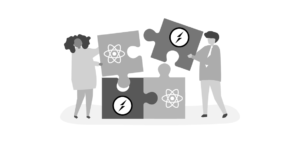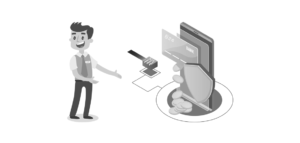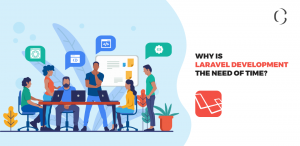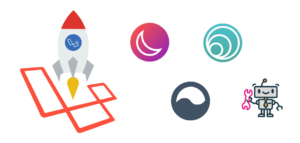US e-commerce market is booming with 49% hike in daily sales in April: Why your business needs a custom e-commerce website + How to develop a custom e-commerce website + latest trends and the future of the e-commerce
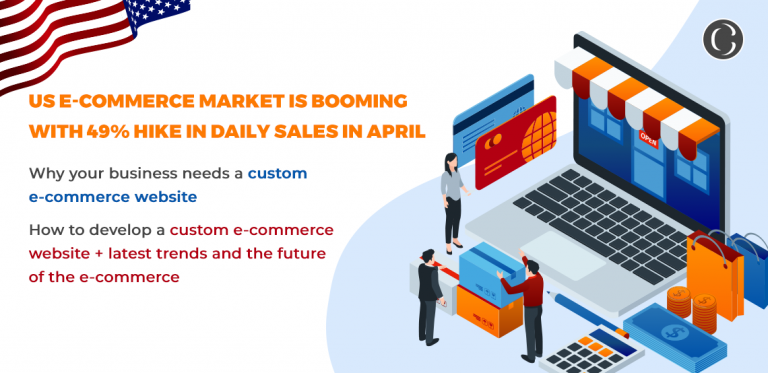
According to Techcrunch, the USA e-commerce sales jumped 49% in April compared to March, and global e-commerce sales have seen a hike of 75% for the same period. Online grocery sales in the USA have seen the highest of 110% boost, while the electronics sales have seen a hike of 58%, and books sales have doubled within just one month.
According to Invesp, the leading 5 countries with the highest average e-commerce revenue per user are the USA with $1,804, the UK with $1,629, Sweden with $1,446, France with $1,228, and Germany with $1,064.
E-commerce purchases are expected to rise from 14.1% in 2019 to 22% in 2023. But despite these remarkable statistics, almost half of the American businesses don’t have their own web store. That’s why now is the perfect time for building one for your business. Let’s understand in detail about the custom e-commerce solution.
Why your business needs a custom e-commerce website:
» Higher outreach:
Unlike marketplaces, customization allows you to market directly to the customers and expand their market. You can send promotional emails to your customers as well as website visitors and engage with a wider audience, as opposed to the standard e-commerce website models where you can reach homogenized groups due to technical, operational, and design bandwidth limitations.
» Personalized campaigns:
The one-size-fits-all approach is not suitable in the current market scenario. Modern customers need personalized marketing campaigns including email marketing, rewards, discounts, offers, etc., that are relevant to them, in terms of age, demand, spending capacities, engagement, and other demographic factors.
» Enhanced features:
Customization helps accommodate the website features as per traffic volumes to counter bounce rates and conversion decline. Nearly 40% of customers abandon the website due to poor loading speed, complicated navigation, or unattractive UI/UX. A delay in page response can lower conversion rates by nearly 7 percent.
» Standing ahead of the market competition:
Customization helps companies to project their brand vision and philosophy, brand value, and uniqueness of their products and services in an effective way. It also helps to upgrade their business locally or internationally, and relevant to the location, audience demographics, etc. All this helps custom e-commerce websites to overcome the market competition by becoming more versatile and audience-specific.
» Enhanced customer experience:
With the ever-growing number of businesses in this industry, customers prefer seamless online shopping, like responsive and mobile-friendly websites, anytime-anywhere shopping, easy returns, faster and direct communication with the customer service executives, multiple payment gateways, etc. These elements can be tweaked and improvised in custom e-commerce websites as per requirements without interrupting the quality of customer services.

(Source: LoadSourse)
Most important steps of the custom e-commerce website development:

» Analyze the successful e-commerce websites:
To understand the current market trends, customer behavior, what is already working for the other e-commerce sites, it is a very important step to analyze the already excelling e-commerce websites and how they are able to convert visitors into customers. This will help you come up with a well-functional and a lucrative solution.
» Go for Open-source or SaaS:
Going for an Open-source platform or a SaaS platform for your e-commerce business will depend on a variety of factors, such as your current and future business goals, budgetary or other constraints, etc. Let’s have a compared view:
| Open-source platform | SaaS platform |
| More technical work required | Less technical work required |
| Set up is slow | Faster set up |
| Complicated to use | Easy to use |
| Allows full control | Less control |
| No hidden costs | Hidden costs |
| High maintenance | Comparatively low maintenance |
| Expensive | Cheaper |
Easy navigations:
Offer your customers clear and easy-to-follow navigation in the process of purchase. In this cut-throat competition, aim at retaining the customers by providing them a clutter-free experience.
Keep your website design coherent with the products you are selling:
While designing, just make sure that everything
on your website from the text, product images, color schemes perfectly aligns with what you are selling. For example, if you are selling toys, then your web-design should look fun and colorful, or if you are selling electronic gadgets, then your web-design should look modern and techy.
» Product showcase and descriptions:
Use high-quality & large-sized images, while showcasing the products on your website to instantly grab the customer’s attention. It will also help your customers to visualize them and feel the product. You can also go with the layout that emphasizes your product on every page. This will surely enhance the user experience on your website.
» Easy checkout and multiple payment options:
The more straightforward the check-out process, the more motivation customers will have to make a repetitive purchase. So don’t create too many pages for checkout, but create a single-page check-out process that is not too overwhelming for customers. By considering your customer’s payment preference, you can provide multiple payment gateways to motivate them for shopping.
» Choosing the right tech partner:
Starting your e-commerce journey with the right tech partner is a very important step to be successful, especially if you are new to this field or from a non-technical background. As e-commerce can get tricky sometimes, and some difficult problems can arise, which can only be handled by experienced developers.
Current trends in e-commerce:
» Visual commerce:
Visual commerce allows customers to interact with the products in an immersive manner with the help of AR/VR. For example, Snapchat allows users to click a photo of a persons’ outfit to buy the same on Amazon. Today, it is very important for businesses to build visual content to remain in the competition.
» Chatbots:
There are 1.4 billion people around the world are using chatbots. E-commerce also has conversational chatbots on their app or websites. Chatbots have been a part of e-commerce for a long time now, but now they got smarter.

Nike’s chatbot is a great example of the smart chatbots, it establishes a better user experience and also boosts sales. It helps users to find the right sneakers by processing the images they upload and taking user preferences into account.
» Voice assistance:
50% of online users prefer voice assistants to buy products; Alexa, Google Assistant, Siri, and Cortana are getting more mainstream. E-commerce businesses need to be voice-search ready for the future. Domino’s is a popular example of leveraging the voice assistant ecosystem to boost its business.
Future trends in e-commerce:
» Omnichannel commerce:
A good omnichannel solution connects customers across multiple devices, multiple locations, and bridges the gap between online and offline channels. It gives users the freedom to choose a variety of touchpoints and eliminates silos to maintain a continuous and seamless experience.
Companies with strong omnichannel customer engagement are able to retain on an average of 89% of their customers, but companies with weak omnichannel customer engagement only able to retain 33% of their customers.
» Unified commerce:
A unified digital experience platform is enterprise software that ties together all the digital experience touchpoints that require the specific suite of elements to work in conjunction with each other and deliver a seamless user experience.
» M-commerce:
Talking about mobile commerce an e-commerce trend is not fair, but It is taking over online shopping by storm, and the research states that by 2021, more than 50% of online sales are going to belong m-commerce.
Smartphones will also be a vital interface in delivering an omnichannel shopping experience, due to the advantages like they make for easier payments, smooth GPS tracking, simpler in operation, faster purchases, and many more.
How Coruscate can help you to develop custom e-commerce website
Coruscate is a leading software development company, accommodating 150+ talented and experienced developers, designers, and business analysts, which will help you through the entire process of developing custom e-commerce solutions, from start to finish.
In the race to the top in the e-commerce market, Coruscate will help you from market analysis to reimagine the possibilities, latest trends, and well-versed solution.
If you want to have a personalized solution for your business, feel free to contact us anytime. Our experienced team will get back to you with a comprehensive solution, a personalized quote, and a live project demo.



